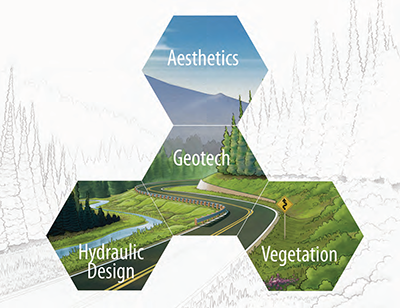Previous Chapter « Table of Contents » Next Chapter
Current literature shows that the terms "sustainable" and "roadside" are not widely associated with each other. However, with over 4 million miles of paved roadways and associated roadsides in this country, it is important to view them as sustainable places rather than leftover spaces (NRC, 2005).
Sustainable roadsides need to be designed with the intent of integrating successful economic, environmental, and social strategies into the built environment. For purposes of this guidebook, roadsides include the edges of the roadway beyond the pavement (travel lanes and shoulders) extending to the right-of-way line.
The purpose of this guidebook is to recommend strategies to better incorporate sustainability into roadside design considerations. The tools and case studies in this guidebook reflect the full project lifecycle from planning through operations and maintenance. The intent is not to create a new design process but rather to integrate sustainability into existing processes. The goal is to raise awareness about the trade-offs inherent in designing a sustainable roadside so that these issues are addressed early-on in project development.
This guidebook is organized by the disciplines involved in roadside restoration, including aesthetics, geotechnical, hydrology, and revegetation (Figure 1-1). Each discipline section begins with a description of the key requirements typically considered in project development. It then introduces common design trade-offs encountered during roadside restoration decisions and follows with recommendations on how to address trade-offs. Finally, each section ends with a checklist of sustainability measures for the specific discipline. The checklists for each discipline have been compiled into one checklist in Appendix A. This checklist is intended to be used as a tool in the project development process.
It is important to note that roadsides are dynamic environments that require unique treatments and restoration approaches. Approaches that may be appropriate for one project may not be appropriate in a different context. The key is to remain flexible in the selection of sustainability practices to best reflect the needs of an individual project.

Figure 1-1: Interrelated disciplines involved in sustainable roadside design
The audience for this guidebook is primarily practitioners in the field of transportation in both the public and private sectors - from planning through construction. Interested persons may be involved in any or all of the steps within a project lifecycle. This guidebook introduces a variety of case studies, mainly in rural contexts. However, the "best practices" and "lessons learned" may be applicable to suburban and urban environments as well.
This guidebook serves as a resource for practitioners who seek to improve the roadside environment. Specifically, it is intended to:
This guidebook is limited to roadside restoration for roadway rehabilitation projects. For new construction or reconstruction projects, refer to the companion to this guidebook titled Integrated Approachfor Building Sustainable Roads: A Guidebook. The companion discusses the integration of sustainability into the roadway design process from planning and programming through operations and maintenance (Federal Highway Administration, 2013).
Sustainable roadsides need to be designed with the intent of integrating successful fiscal, environmental, and social strategies into the built environment. An integral part of maintaining a sustainable roadside is the ability to provide safety to users. A safe, sustainable roadside should consider:
It should be noted that little research has been conducted studying the relationship between sustainability and roadside safety. Designers must look into trade-offs, construction costs, and lifecycle costs in comparison to other roadside elements in order to develop sustainable roadsides. Standards and research through entities such as the National Cooperative Highway Research Program (NCHRP) can assist in selecting appropriate strategies. Each technical section of this guidebook includes a section on safety considerations to show the relationship between safety and sustainability.